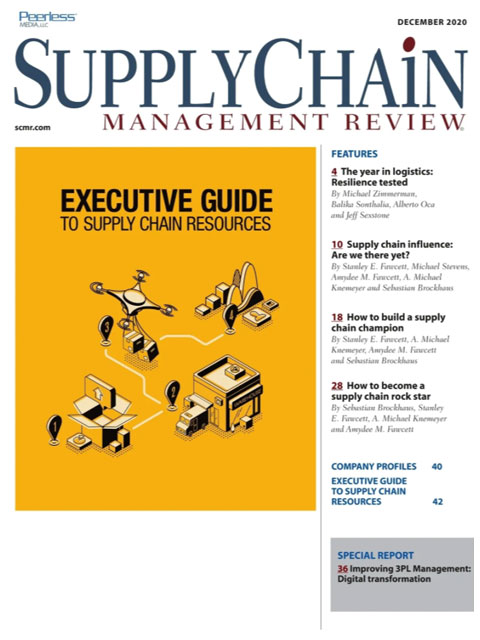Sorry, but your login has failed. Please recheck your login information and resubmit. If your subscription has expired, renew here.
December 2020
Each December, the focus of the issue is our annual Executive Guide to Supply Chain Resources. This is a comprehensive guide to services, products and educational opportunities targeted specifically to supply chain professionals. But, as with years past, we’re also featuring several articles we trust will give you something to think about in the coming year. Browse this issue archive.Need Help? Contact customer service 847-559-7581 More options
Bitter rivals, Airbus and Boeing have engaged in a 25-year dogfight for air supremacy. Boeing held a commanding early edge in orders and deliveries. However, fueled by fly-by-wire technology, Airbus persistently closed the gap. By 1999, Airbus took the orders lead. By 2003, Airbus passed Boeing in deliveries. Boeing’s new reality was clear: As a fierce and capable rival, Airbus wasn’t going away.
Redefining the rules
As they looked to the 21st century, Airbus and Boeing both sought to redefine the competitive rules. Airbus’ goal: Eliminate Boeing’s big advantage—its 747 jumbo-jet monopoly. For four decades, the 747 had given Boeing a double advantage: prestige and cash flow. Boeing had sold almost 1,400 copies of the iconic 747, spinning off profits to fund hugely successful new planes like the 737 and 777. For Boeing, the goal was simple: Find a way to sell and deliver more planes than Airbus.
The two rivals chose distinct routes. Airbus announced the A380 in early 2000. The double-decker plane would carry 550 passengers in a traditional three-cabin layout, reducing per-passenger costs by 15%. Airbus forecast orders would come streaming in—totaling 1,200 units by 2020. Not wanting to cede bragging rights, Boeing almost doubled down on its own new super jumbo. But, after running the numbers, Boeing decided the market wasn’t big enough for two super jumbos. Boeing forecast a total market as small as 325 planes.
Boeing announced its own new plane—the 7E7 (E for efficiency)—in January 2003. Dubbed the “Dreamliner” in Boeing’s “Name Your Plane” contest, the plane was later designated the 787. As the first commercial airframe made out of lightweight carbon-fiber, the 787 would reduce operating costs by 20% and be 33% less expensive to maintain. The 787 would also offer improved comfort—larger windows, increased cabin pressure, and higher humidity, allowing frequent flyers to arrive from long-haul flights feeling more rested.

This complete article is available to subscribers only.
Log in now for full access or start your PLUS+ subscription for instant access.
SC
MR
Sorry, but your login has failed. Please recheck your login information and resubmit. If your subscription has expired, renew here.
December 2020
Each December, the focus of the issue is our annual Executive Guide to Supply Chain Resources. This is a comprehensive guide to services, products and educational opportunities targeted specifically to supply chain… Browse this issue archive. Access your online digital edition. Download a PDF file of the December 2020 issue.Bitter rivals, Airbus and Boeing have engaged in a 25-year dogfight for air supremacy. Boeing held a commanding early edge in orders and deliveries. However, fueled by fly-by-wire technology, Airbus persistently closed the gap. By 1999, Airbus took the orders lead. By 2003, Airbus passed Boeing in deliveries. Boeing’s new reality was clear: As a fierce and capable rival, Airbus wasn’t going away.
Redefining the rules
As they looked to the 21st century, Airbus and Boeing both sought to redefine the competitive rules. Airbus’ goal: Eliminate Boeing’s big advantage—its 747 jumbo-jet monopoly. For four decades, the 747 had given Boeing a double advantage: prestige and cash flow. Boeing had sold almost 1,400 copies of the iconic 747, spinning off profits to fund hugely successful new planes like the 737 and 777. For Boeing, the goal was simple: Find a way to sell and deliver more planes than Airbus.
The two rivals chose distinct routes. Airbus announced the A380 in early 2000. The double-decker plane would carry 550 passengers in a traditional three-cabin layout, reducing per-passenger costs by 15%. Airbus forecast orders would come streaming in—totaling 1,200 units by 2020. Not wanting to cede bragging rights, Boeing almost doubled down on its own new super jumbo. But, after running the numbers, Boeing decided the market wasn’t big enough for two super jumbos. Boeing forecast a total market as small as 325 planes.
Boeing announced its own new plane—the 7E7 (E for efficiency)—in January 2003. Dubbed the “Dreamliner” in Boeing’s “Name Your Plane” contest, the plane was later designated the 787. As the first commercial airframe made out of lightweight carbon-fiber, the 787 would reduce operating costs by 20% and be 33% less expensive to maintain. The 787 would also offer improved comfort—larger windows, increased cabin pressure, and higher humidity, allowing frequent flyers to arrive from long-haul flights feeling more rested.
SC
MR


Latest Supply Chain News
Latest Podcast

 Explore
Explore
Business Management News
- Strengthening customer fulfillment: Building a strategic stakeholder network
- The hard job of teaching soft skills
- Trump picks former Wisconsin congressman Sean Duffy for DOT secretary
- Made in Mexico, manufactured by China
- Retail sales see gains in October, reports Commerce and NRF
- Balancing green and speed: Home delivery insights from the pandemic era
- More Business Management
Latest Business Management Resources

Subscribe

Supply Chain Management Review delivers the best industry content.

Editors’ Picks





